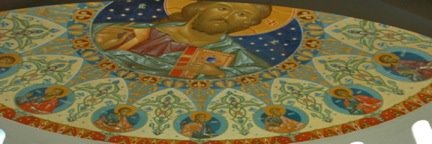
The Stations of the Cross are a Catholic devotion which commemorates the Passion and death of our Lord Jesus Christ. Each of the fourteen stations represents an event which occurred during Jesus' Passion and death at Calvary on Good Friday.
The Stations were originally performed many centuries ago by Christian pilgrims who visited the Holy Land and the sites of Jesus' Passion. Promotion of the devotion to the Stations began in earnest with the Franciscans, who were given custody of the Holy Places in the Holy Land in the 1300s. Countless Catholics have all enriched their spiritual lives with this powerful devotion.
The Stations of the Cross, also called The Way of the Cross, is a devotion to the passion of Christ consisting of prayers and meditations on fourteen occurrences that were experienced by Christ on His way to the crucifixion. During the time of the crusades (1095-1270), it became popular for pilgrims in the Holy Land to walk in the footsteps of Jesus to Calvary. After the Moslems recaptured the Holy Land pilgrimages were too dangerous. As a result, the Stations of the Cross became a popular substitute pilgrimage throughout Europe.
The Stations represented critical events from Scripture or tradition of Jesus' journey to Calvary. Originally done only outdoors, the Stations were allowed inside churches in the mid-18th century. Eventually fixed at fourteen, the Stations soon became a familiar feature in all Catholic churches.
The devotion may be conducted personally by the faithful, making their way from one station to another and saying the prayers, or by having an officiating celebrant move from cross to cross while the faithful make the responses. The stations themselves must consist of, at the very least, fourteen wooden crosses, pictures alone do not suffice, and they must be blessed by someone with the authority to erect stations.
Origins of the Stations: 4th Century Jerusalem
The devotion originated in the late 4th century when pilgrims flocked to the Holy Land from all parts of the world to visit the land of Jesus. Heading the list of places they visited was the Church of the Holy Sepulcher, which had been built by the Emperor Constantine in 335 AD atop Calvary and the tomb of Jesus.
Processions of pilgrims to this church were common. Egeria, a woman from Gaul who traveled to the Holy Land in the 4th century, recalls in her diary how she joined Christians from all parts of the Roman world walking westward on Holy Thursday from the garden of Gethsemane to the church of the Holy Sepulcher, where they celebrated Jesus' death and resurrection.
Take a look at her account of Holy Thursday in Jerusalem.
From the diary of Egeria, a woman from Gaul who traveled to the Holy Land in the 4th Century, Egeria's account of Christians from all parts of the Roman world walking westward on Holy Thursday from the garden of Gethsemane to the church of the Holy Sepulcher, where they celebrated Jesus' death and resurrection:
And at the first cockcrow they come down from the Imbomon with hymns, and arrive at the place where the Lord prayed, as it is written in the Gospel: and He was withdrawn [from them] about a stone's cast, and prayed, and the rest. There is in that place a graceful church. The bishop and all the people enter, a prayer suitable to the place and to the day is said, with one suitable hymn, and the passage from the Gospel is read where He said to His disciples: Watch, that ye enter not into temptation. The whole passage is read through and prayer is made. And then all, even to the smallest child, go down with the Bishop, on foot, with hymns to Gethsemane. There, on account of the great number of people in the crowd who are wearied owing to the vigils and weak through the daily fasts, and because they have so great a hill to descend, they come very slowly with hymns to Gethsemane. And over two hundred church candles are made ready to give light to all the people. On their arrival at Gethsemane, first a suitable prayer is made, then a hymn is said, and then the passage of the Gospel is read where the Lord was taken. And when this passage has been read there is so great a moaning and groaning of all the people, together with weeping, that their lamentation may be heard perhaps as far as the city. From that hour they go with hymns to the city on foot, reaching the gate about the time when one man begins to be able to recognize another, and thence right on through the midst of the city. All, to a man, both great and small, rich and poor, all are ready there, for on that special day not a soul withdraws from the vigils until morning. Thus the bishop is escorted from Gethsemane to the gate, and thence through the whole of the city to the Cross.
Based on the translation reproduced in Louis Duchesme's Christian Worship, London, 1923
The Via Dolorosa
Over the years, the route of pilgrim processions -- beginning at the ruins of the Fortress Antonia and ending at the church of the Holy Sepulcher -- was accepted as the way that Jesus went to his death. It was known as the "Via Dolorosa," the "Sorrowful Way;" Today, it winds through the crowded areas of Jerusalem's Old City, and pilgrims still travel it in prayer.

"Stations" developed on this venerable route as early pilgrims honored places where specific incidents took place as Jesus went Calvary. However, the search for them was complicated because the Jerusalem of Jesus' day had been almost completely destroyed by Roman armies in 70 AD. In many cases, therefore, pilgrims could only guess where some incidents described in the gospel took place.
From the Holy Land to Europe
Christian pilgrims contributed to the European development in Europe of the Stations of the Cross in its present form. Returning from the Holy Land, they brought oil from the lamps that burned around Jesus' tomb, soil. and relics from the holy places. More important, they brought memories of the liturgies, devotions, and shrines they experienced. Soon, churches and shrines were being built throughout Europe modeled on the pilgrim sites, and Jerusalem's devotions and liturgies influenced the liturgical and religious life of western Christians.
The Moslem conquest of Palestine in the 7th century contributed to the building of replicas of the holy places in Europe, as Christians, finding access to the holy places more difficult, sought places of pilgrimage nearer home. If they could not go to Jerusalem, they would have reminders of Jerusalem close by.
Devotion to the Stations of the Cross spread rapidly throughout the Roman Catholic world in the 18th century, largely as a result of the preaching of the Franciscan, St. Leonard of Port -Maurice, who erected stations and promoted the devotion in over five hundred churches and places throughout Italy. His work was supported by the popes of his time, who saw the devotion as a means of strengthening faith.
Another 18th century saint, St. Alphonsus Liguori, wrote a brief work on the stations that is still in use today. Religious communities like the Jesuits and the Passionsts made the devotion part of their missions and retreats. By the l9th century, the Stations of the Cross had become a staple in Catholic prayer books and in churches throughout England, Ireland, and North America.

The 14 Stations of the Cross
Jesus is Condemned to Die
Jesus is Made to Bear His Cross
Jesus Falls the First Time
Jesus Meets His Mother
Simon Helps Jesus Carry His Cross
Veronica Wipes Jesus' Face
Jesus Falls the Second Time
Jesus Meets the Women of Jerusalem
Jesus Falls the Third Time
Jesus is Stripped
Jesus is Nailed to the Cross
Jesus Dies on the Cross
Jesus is Taken Down from the Cross
Jesus is Laid in the Tomb







































thank you for your lovely presentation of the Stations of the Cross. I hope you do not mind that I have provided a link to this post on my blog -newhorizons-mynewhorizons.blogspot.com since I believe my readers would find it as informative as I have.
ReplyDelete